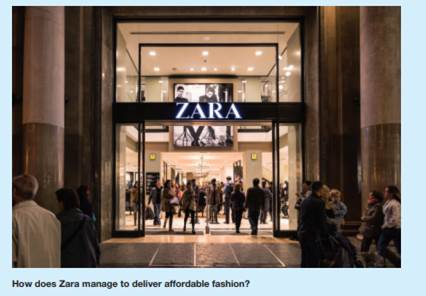Zara rewrites the rules on marketing and supply chain management
Zara is one of the hottest fashion chains of the 21st century. Founded in 1975, Zara’s parent, Inditex, has become one of the leading global apparel retailers. Since its initial public offering (IPO) in 2001, Inditex has tripled its sales and profits and doubled the number of its stores of eight brands, of which Zara contributes two-thirds of total sales. In early 2018, Inditex’s market capitalization exceeded €100 billion, far ahead of its rival H&M (market cap: €18 billion). Zara succeeds by breaking and then rewriting rules on marketing and supply chain management.
Rule number one: The place of origin of a fashion house critically shapes its brand image. However, Zara does not hail from Milan or Paris – it is from Arteixo, a town of only 25 000 people in Galicia, a remote province of north-western Spain. Yet Zara is active in Europe, the Americas, Asia, Australia and Africa. By 2018, Inditex was operating 7500 stores in 96 countries, including 2251 Zara stores. Zara stores occupy some of the priciest locations: Paris’s Champs-Elysées, Tokyo’s Ginza and New York’s Fifth Avenue.
Rule number two: Avoid stock-outs (a store running out of items in demand). But Zara believes that occasional shortages contribute to an urge to buy now. With new items arriving at stores twice a week, experienced Zara shoppers know that if you see something and don’t buy it, you can forget about coming back for it, because it will be gone. The small batch of merchandise during a short window of opportunity for purchasing motivates shoppers to visit Zara stores more frequently. In London, shoppers visit the average store four times a year but frequent Zara 17 times annually. There is a good reason to do so: Zara makes about 20 000 items a year, about triple what Gap does. As a result, ‘At Gap, everything is the same’, according to a Zara fan, ‘and buying from Zara, you’ll never end up looking like someone else’.
Rule number three: Bombard shoppers with ads. Gap and H&M spend on average 3 to 4% of their sales on advertising. Zara devotes just 0.3% of its sales to ads. The high traffic in the stores alleviates some of the need for advertising in the media, most of which only serves as a reminder to visit the stores.
Rule number four: Outsource. Gap and H&M do not own any production facilities. However, outsourcing production (mostly to Asia) requires a long lead time, usually several weeks. Again, Zara deviates from the norm. By concentrating 59% of its factories in proximity to its headquarters in Arteixo, Zara has developed a super-responsive supply chain. It designs, produces and delivers new garments to its stores worldwide in a mere 15 days, a pace that is unheard of in the industry. The best speed the rivals can achieve is two months. Outsourcing may not necessarily be ‘low cost’, 
because errors in prediction can easily lead to unsold inventory, forcing retailers to offer steep discounts. The industry average is to offer 40% discounts across all merchandise. In contrast, Zara sells more at full price, and when it discounts, it averages only 15%.
Rule number five: Strive for efficiency through large batches. In contrast, Zara intentionally deals with small batches. Because of its flexibility, Zara does not worry about ‘missing the boat’ for a season. When new trends emerge, Zara can react quickly. More interestingly, Zara runs its supply chain like clockwork, with a fast but predictable rhythm: every store places orders on Tuesday/Wednesday and Friday/Saturday. Trucks and cargo flights run on established schedules – like a bus service. From Spain, shipments reach most European stores in 24 hours, US stores in 48 hours and Asian stores in 72 hours. Not only do store staff know exactly when shipments will arrive, regular customers do too, thus motivating them to check out the new merchandise more frequently on those days. Mr Isla, Inditex’s CEO, thus emphasizes that the success of Inditex is not just about speed but about understanding customers, responding to them: ‘Instead of designing a collection long before the season, and then working out whether clients like it or not, we try to understand what our customers like, and then we design it and produce it’.
Focused initially on Western Europe, Zara has expanded in the 2000s to emerging economies; more than 50% of new shops opened are in places such as China, Russia, Poland and Mexico. Zara adapts its business model as appropriate, using fewer but larger outlets. Online retailers such as Berlin-based Zalando (founded 2008) and London-based ASOS (founded in 2000) are challenging Zara. Their online only supply chain gives them higher degrees of flexibility and faster delivery to consumers, especially the millennial generation. Zara has developed its own online presence since 2010 and was serving 46 countries through its online shops by 2018. Yet, the competition of more e-commerce savvy competitors puts pressure on its business model.

